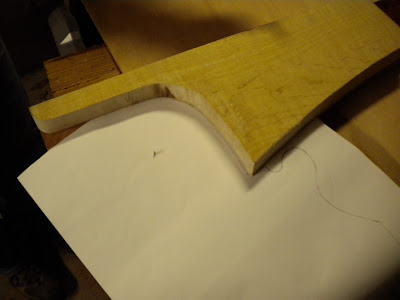Spent the afternoon making the tiller. We had already cut out the three pieces - drew out the tiller from the plans on curly maple, then traced the maple outline onto two pieces of a red cedar board. With the three pieces clamped together, we sanded them until they were all the same size and shape.
With all three pieces, the tiller is too fat for a comfortable grip when steering. So we sent the two pieces of cedar through the planer. As I pulled them through the planer, Daddy cranked the blade lower and lower, thus shaving off more wood evenly towards the ends of the boards. Now the tiller is tapered down to a comfortable width for holding onto (photo later).
Gluing the tiller together!
Setting all the clamps was tricky - with all the glue in between, the pieces of wood want to slide every which way. We tried clamping the two ends first, then the middle, then working in from each end, but as soon as we added a clamp near either end, the outside pieces of wood would squish up or down or backwards or forwards, leaving uneven edges. We ended up putting two screws into the back end of the tiller, one on each side to hold it in place so that we could get the clamps all set with the pieces of wood all lined up perfectly. That worked well.
Of course I ended up with epoxy all over my gloves, and then proceeded to touch the wood all over while trying to hold it together while we tightened clamps, but then we realized we were going to be gluing the little blocks of wood under the clamps to the tiller, so we had to put slips of wax paper under each wood block. The wood blocks just keep the clamps from damaging the wood of whatever you are gluing.

Right before we starting gluing, we noticed a little hole in the outside of one of the cedar pieces. We stuck a screw driver into the hole to punch out any loose wood, and the hole turned out to be deeper than expected. We can't have a hole in the tiller (or anywhere else!), so after we finished gluing the tiller pieces, we used a little left over liquid epoxy to mix up a filler for the hole. By mixing in wood dust into the liquid from the wood that you're filling, you get a filler that matches the wood color. So we have a nice cedar filler for the hole that will blend right in with the rest of the side of the tiller - hopefully.

Tonight we were planning on gluing the rudder strips together so that we could get on with drawing and cutting that out, but the saw we used to rip the pieces cut them at weird angles because the saw blade sags just a tiny bit (it's a really old saw), so we have to try to fix that before we can put the rudder together. Right now when the pieces of the rudder are pushed together, there are little gaps and some pieces want to be tilted at a slight angle to meet the edge of another piece.






























